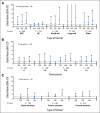C-reactive protein and risk of lung cancer
- PMID: 20421535
- PMCID: PMC2881850
- DOI: 10.1200/JCO.2009.27.0454
C-reactive protein and risk of lung cancer
Abstract
Purpose: Chronic inflammation could play a role in lung carcinogenesis, underscoring the potential for lung cancer prevention and screening. We investigated the association of circulating high-sensitivity C-reactive protein (CRP, an inflammation biomarker) and CRP single nucleotide polymorphisms (SNPs) with prospective lung cancer risk.
Patients and methods: We conducted a nested case-control study of 592 lung cancer patients and 670 controls with available prediagnostic serum and 378 patients and 447 controls with DNA within the screening arm of the Prostate, Lung, Colorectal, and Ovarian Cancer Screening Trial (N = 77,464). Controls were matched to patients on age, sex, entry year, follow-up time, and smoking. We measured CRP levels in baseline serum samples and genotyped five common CRP SNPs.
Results: Elevated CRP levels were associated with increased lung cancer risk (odds ratio [OR], 1.98; 95% CI, 1.35 to 2.89; P-trend < .001 for fourth quartile [Q4, > or = 5.6 mg/L] v Q1 [< 1.0 mg/L]). The CRP association did not differ significantly by histology, follow-up time, or smoking status, but was most apparent for squamous cell carcinomas (OR, 2.92; 95% CI, 1.30 to 6.54), 2 to 5 years before lung cancer diagnosis (OR, 2.33; 95% CI, 1.24 to 4.39), and among former smokers (OR, 2.48; 95% CI, 1.53 to 4.03) and current smokers (OR, 1.90; 95% CI, 1.06 to 3.41). Although CRP SNPs and haplotypes were associated with CRP levels, they were not associated with lung cancer risk. Ten-year standardized absolute risks of lung cancer were higher with elevated CRP levels among former smokers (Q4: 2.55%; 95% CI, 1.98% to 3.27% v Q1: 1.39%; 95% CI, 1.07% to 1.81%) and current smokers (Q4: 7.37%; 95% CI, 5.81% to 9.33% v Q1: 4.03%; 95% CI, 3.01% to 5.40%).
Conclusion: Elevated CRP levels are associated with subsequently increased lung cancer risk, suggesting an etiologic role for chronic pulmonary inflammation in lung carcinogenesis.
Conflict of interest statement
Authors' disclosures of potential conflicts of interest and author contributions are found at the end of this article.
Figures

Similar articles
-
Circulating inflammation markers and prospective risk for lung cancer.J Natl Cancer Inst. 2013 Dec 18;105(24):1871-80. doi: 10.1093/jnci/djt309. Epub 2013 Nov 18. J Natl Cancer Inst. 2013. PMID: 24249745 Free PMC article.
-
Circulating high sensitivity C reactive protein concentrations and risk of lung cancer: nested case-control study within Lung Cancer Cohort Consortium.BMJ. 2019 Jan 3;364:k4981. doi: 10.1136/bmj.k4981. BMJ. 2019. PMID: 30606716 Free PMC article.
-
Serum C-reactive protein and risk of lung cancer: a case-control study.Med Oncol. 2013 Mar;30(1):319. doi: 10.1007/s12032-012-0319-4. Epub 2012 Dec 15. Med Oncol. 2013. PMID: 23254959
-
Circulating Leptin and Risk of Pancreatic Cancer: A Pooled Analysis From 3 Cohorts.Am J Epidemiol. 2015 Aug 1;182(3):187-97. doi: 10.1093/aje/kwv041. Epub 2015 Jun 17. Am J Epidemiol. 2015. PMID: 26085045 Free PMC article. Review.
-
C-reactive protein as a predictor of disease in smokers and former smokers: a review.Int J Clin Pract. 2009 Nov;63(11):1634-41. doi: 10.1111/j.1742-1241.2009.02179.x. Epub 2009 Aug 29. Int J Clin Pract. 2009. PMID: 19732183 Free PMC article. Review.
Cited by
-
Evaluation of urinary C-reactive protein as an early detection biomarker for pancreatic ductal adenocarcinoma.Front Oncol. 2024 Sep 6;14:1450326. doi: 10.3389/fonc.2024.1450326. eCollection 2024. Front Oncol. 2024. PMID: 39309742 Free PMC article.
-
Exploration of the causal relationship between inflammatory cytokines and prostate carcinoma: a comprehensive Mendelian randomization study.Front Oncol. 2024 Aug 29;14:1381803. doi: 10.3389/fonc.2024.1381803. eCollection 2024. Front Oncol. 2024. PMID: 39267848 Free PMC article.
-
The Association between Blood Test Trends and Undiagnosed Cancer: A Systematic Review and Critical Appraisal.Cancers (Basel). 2024 Apr 26;16(9):1692. doi: 10.3390/cancers16091692. Cancers (Basel). 2024. PMID: 38730644 Free PMC article. Review.
-
Symbiotic microbial communities in various locations of the lung cancer respiratory tract along with potential host immunological processes affected.Front Cell Infect Microbiol. 2024 Feb 2;14:1296295. doi: 10.3389/fcimb.2024.1296295. eCollection 2024. Front Cell Infect Microbiol. 2024. PMID: 38371298 Free PMC article. Review.
-
CRP, IL-1α, IL-1β, and IL-6 levels and the risk of breast cancer: a two-sample Mendelian randomization study.Sci Rep. 2024 Jan 23;14(1):1982. doi: 10.1038/s41598-024-52080-w. Sci Rep. 2024. PMID: 38263420 Free PMC article.
References
-
- Alberg AJ, Brock MV, Samet JM. Epidemiology of lung cancer: Looking to the future. J Clin Oncol. 2005;23:3175–3185. - PubMed
-
- Bauer AK, Dwyer-Nield LD, Keil K, et al. Butylated hydroxytoluene (BHT) induction of pulmonary inflammation: A role in tumor promotion. Exp Lung Res. 2001;27:197–216. - PubMed
-
- Ballaz S, Mulshine JL. The potential contributions of chronic inflammation to lung carcinogenesis. Clin Lung Cancer. 2003;5:46–62. - PubMed
-
- Engels EA. Inflammation in the development of lung cancer: Epidemiological evidence. Expert Rev Anticancer Ther. 2008;8:605–615. - PubMed
-
- Santillan AA, Camargo CA, Jr, Colditz GA. A meta-analysis of asthma and risk of lung cancer (United States) Cancer Causes Control. 2003;14:327–334. - PubMed
Publication types
MeSH terms
Substances
Grants and funding
LinkOut - more resources
Full Text Sources
Other Literature Sources
Medical
Research Materials
Miscellaneous

